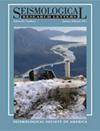On the Use of Instrumental and Macroseismic Data to Evaluate Ground-Motion Models: The 2019 Mw 6.4 Durres, Albania, Earthquake Sequence
IF 3.2
3区 地球科学
Q2 GEOCHEMISTRY & GEOPHYSICS
引用次数: 0
Abstract
In this study, we analyze the existing ground-motion models (GMMs) applicable in Albania for horizontal peak ground acceleration (PGA) and spectral acceleration (SA) using instrumental ground motions, and also incorporate online citizen responses from “Did you feel it?” (DYFI) to compensate for the sparse distribution of strong-motion stations and provide better constraints for near-fault motions. Our evaluation focuses primarily on the damaging 26 November 2019 Mw 6.4 Durres earthquake, incorporating 1360 DYFI online citizen responses collected after the Durres mainshock event, along with two significant September foreshocks and two large November aftershocks with a moment magnitude Mw>5.0. In general, the DYFI intensities exhibit higher values than instrumentation data, and we find that SA at 0.3 s better represents the observed macroseismic intensities for all events. In the meantime, the reversible relationships between macroseismic intensities and PGA/SA, as established by Oliveti et al. (2022) based on a dataset from the European region (Italy), show a better fit for the converted DYFI observations when compared to instrumental data, in contrast to the fit of the converted DYFI observations by Worden et al. (2012). This underscores the importance of regional characterization when considering the datasets from online citizen responses. The extensive DYFI intensities set, particularly in near-fault regions, significantly improves the evaluation of GMMs due to the sparse distribution of instrumentation data. Moreover, we account for data variance, and applied the log-likelihood approaches to select and rank a candidate set of GMMs. In addition to recommending a set of GMMs suitable for the Albania region, our study highlights the valuable applications of using online citizen responses like DYFI for ground-motion estimations, which are crucial in regions with limited instrumental station coverage. These online citizen response datasets contribute to better constraining the selection of GMMs, although careful consideration is necessary when relating intensity to ground motion for regional characterization. Our study makes a significant contribution to GMM selection and provides a valuable reference for the logic tree structure in subsequent seismic hazard assessments on both national and regional scales.利用仪器和宏观地震数据评估地动模型:2019 年阿尔巴尼亚都拉斯 6.4 级地震序列
在这项研究中,我们分析了适用于阿尔巴尼亚的现有地动模型 (GMM),利用仪器地动测量水平峰值地面加速度 (PGA) 和频谱加速度 (SA),并结合 "你感觉到了吗?(DYFI)的在线市民回复,以弥补强震站分布稀疏的问题,并为近断层运动提供更好的约束条件。我们的评估主要侧重于 2019 年 11 月 26 日发生的破坏性 Mw 6.4 级都拉斯地震,纳入了都拉斯主震事件后收集到的 1360 条 DYFI 在线公民响应,以及 9 月份的两次重大前震和 11 月份的两次瞬间震级 Mw>5.0 级的大型余震。一般来说,DYFI 强度值高于仪器数据,我们发现 0.3 秒的 SA 更能代表所有事件的观测到的宏观地震强度。与此同时,Oliveti 等人(2022 年)根据欧洲地区(意大利)的数据集建立的宏观地震烈度与 PGA/SA 之间的可逆关系显示,与仪器数据相比,转换后的 DYFI 观测数据的拟合效果更好,这与 Worden 等人(2012 年)转换后的 DYFI 观测数据的拟合效果形成鲜明对比。这强调了在考虑来自在线公民响应的数据集时区域特征描述的重要性。由于仪器数据分布稀疏,广泛的 DYFI 强度集,尤其是在近断层区域,大大提高了对 GMM 的评估。此外,我们还考虑了数据方差,并应用对数似然法选择和排列了一组候选 GMM。除了推荐一套适合阿尔巴尼亚地区的 GMMs 之外,我们的研究还强调了使用 DYFI 等在线公民响应进行地动估算的宝贵应用价值,这在仪器站覆盖范围有限的地区至关重要。这些在线公民响应数据集有助于更好地限制 GMM 的选择,但在将强度与地动联系起来进行区域特征描述时,有必要谨慎考虑。我们的研究为 GMM 的选择做出了重大贡献,并为后续国家和区域范围的地震灾害评估中的逻辑树结构提供了宝贵的参考。
本文章由计算机程序翻译,如有差异,请以英文原文为准。
求助全文
约1分钟内获得全文
求助全文
来源期刊

Seismological Research Letters
地学-地球化学与地球物理
CiteScore
6.60
自引率
12.10%
发文量
239
审稿时长
3 months
期刊介绍:
Information not localized
 求助内容:
求助内容: 应助结果提醒方式:
应助结果提醒方式:


